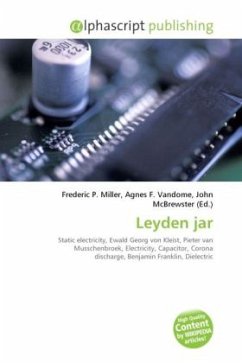High Quality Content by WIKIPEDIA articles! The Leyden jar, or Leiden jar, is a device that "stores" static electricity between two electrodes on the inside and outside of a jar. It was invented independently by German cleric Ewald Georg von Kleist on 11th October 1744 and by Dutch scientist Pieter van Musschenbroek of Leiden Leyden in 1745 1746 . The invention was named for this city. It was the original form of the capacitor. The Leyden jar was used to conduct many early experiments in electricity, and its discovery was of fundamental importance in the study of electricity. Previously, researchers had to resort to insulated conductors of large dimensions to store charge. The Leyden jar provided a much more compact alternative. A typical design consists of a glass jar with conducting metal foil coating the inner and outer surfaces. The foil coatings stop short of the mouth of the jar, to prevent the charge from arcing between the foils.








